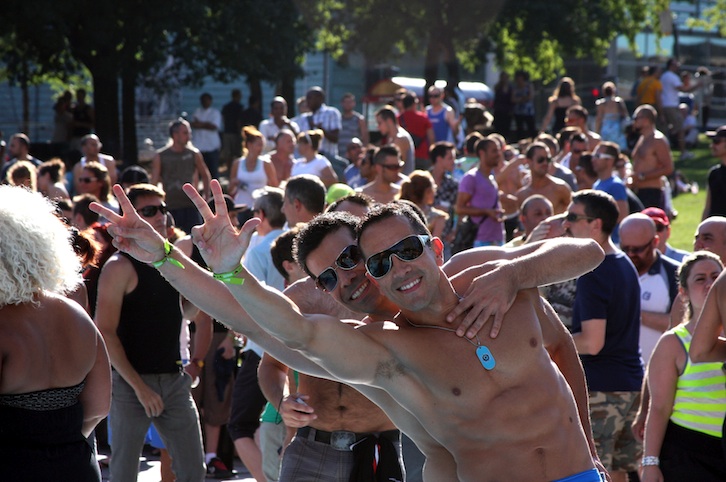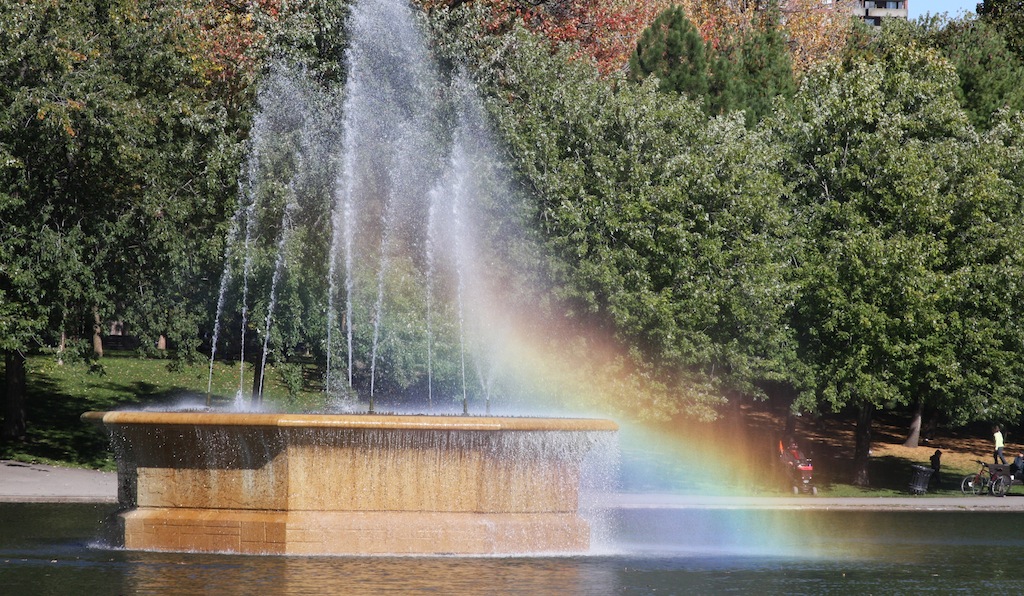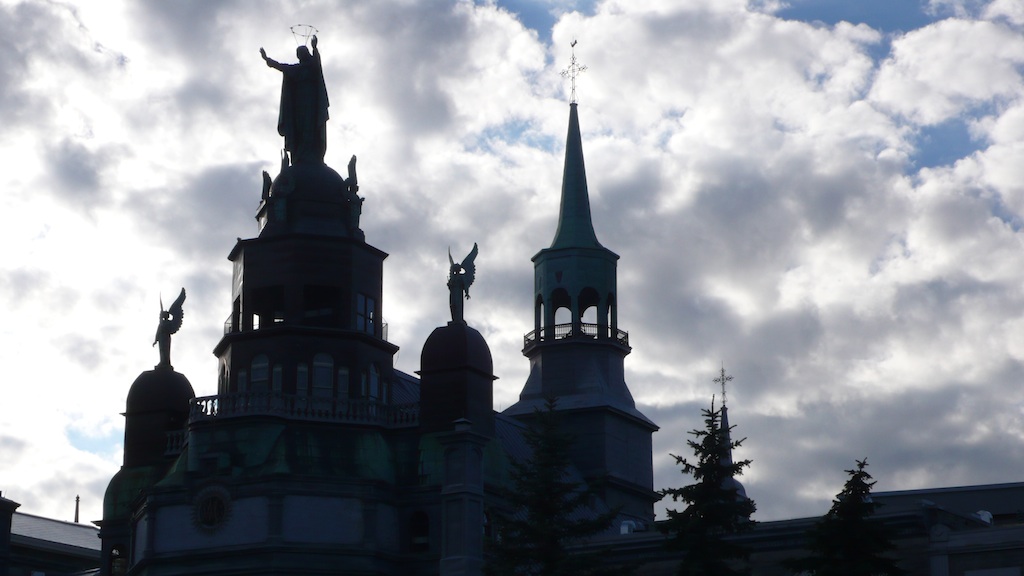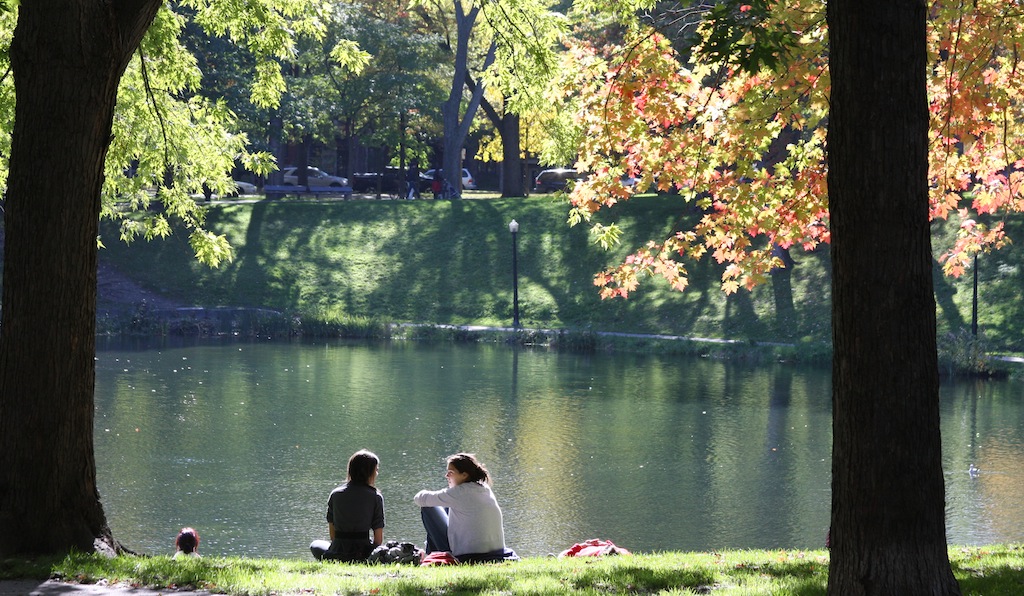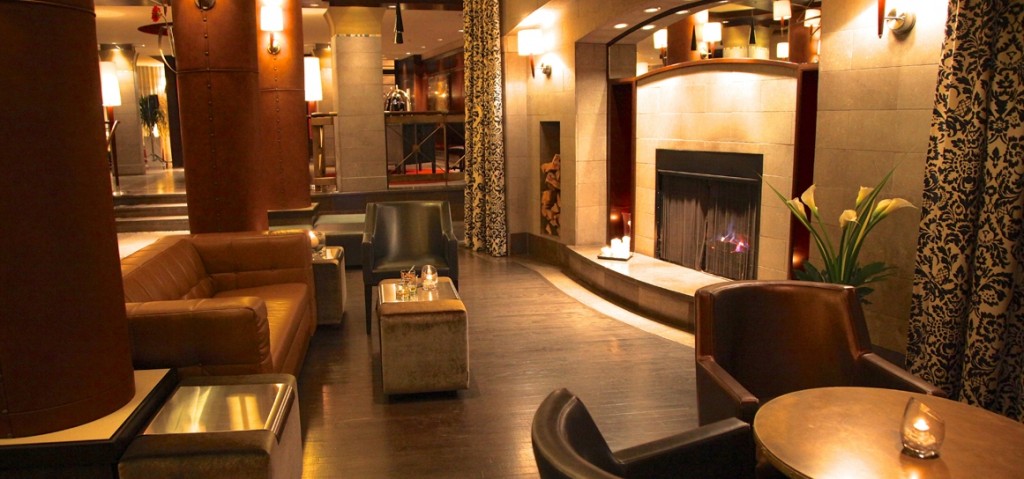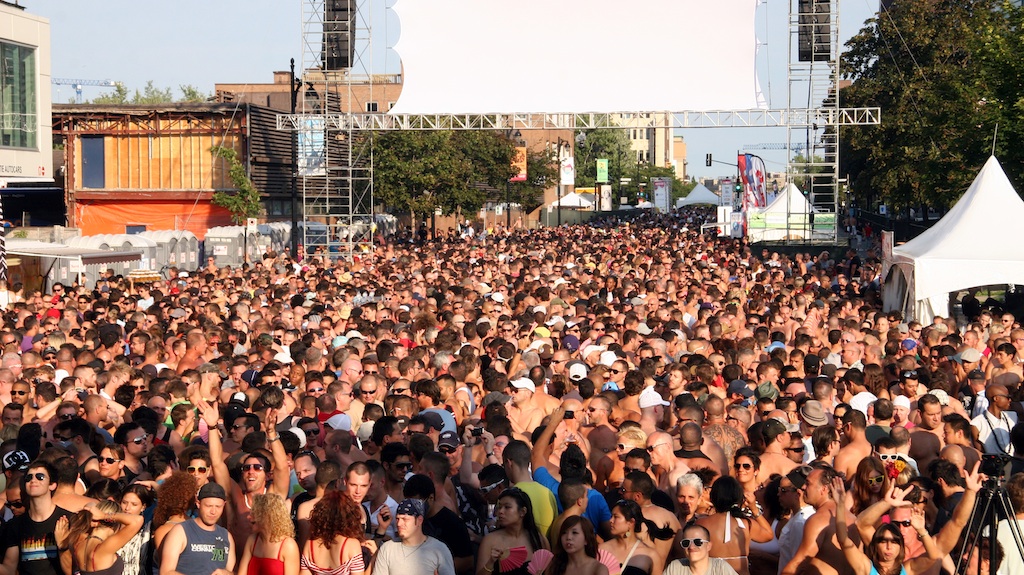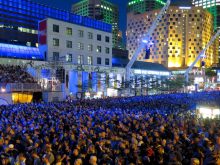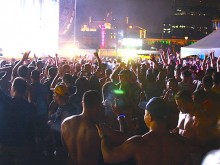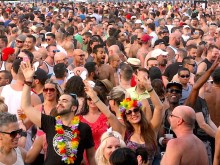Some locals claim that Montreal has only two seasons: winter and festivals. When winter ends, it’s festival season. Months and months of festivals. Festivals all over the city: music festivals and gay festivals, movie festivals and comedy festivals and jazz and arts and culinary festivals. For at least nine months a year, Montreal is an ongoing festival of fun.
I first fell in love with Montreal as a kid when my family traveled there on vacation for Expo 67, the World’s Fair that was based on Antoine de Saint-Exupery’s “Terre des Hommes,” Exupery’s 1939 book about dreams and hopes for the future.
Probably the most successful world’s fair of the 20th century, Expo 67 celebrated Canada’s centennial year and even today many Canadians recall it with the same fondness that New York historians feel about the 1939 World’s Fair.
What I recall most vividly about Expo 67 was visiting Habitat 67, the modular housing complex designed by Moshe Safdie. Upon seeing what was then referred to as a “bachelor’s apartment,” I declared to my family that this was where I was going to live as an adult.
Montreal has long appealed to gay people, something that must’ve registered with me even as a pubescent. Apart from the fact that the city’s original name was Ville-Marie or “City of Mary,” there’s the issue of Montreal’s duality. After all, this is a bilingual city that was founded by both a man, Paul Maisonneuve, and a woman, Jeanne Mance.
The roots of Montreal’s gay village go back to 1869, to a cake shop on St. Antoine Street that was reputedly gay. Today, the Village is centered on St. Catherine Street and readily identifiable by the rainbow pillars at the entrance to the Beaudry Metro station.
For the past few summers, the heart of the gay village has been closed to vehicular traffic from May through September. With the cars and cabs replaced with pedestrians, the backbone of Montreal’s gayborhood becomes a kind of Canadian piazza lined with terraces, pergolas, gazebos, and cafés.
During festival season, “Les Boules Roses” (or “Pink Balls”), a public art installation of 170,000 pink resin balls, dangles above St. Catherine Street to form a pink pearl canopy below which pedestrians parade for eighteen blocks. If you thought the Yellow Brick Road was the apex of gay, then you have yet to preen and pose beneath “Les Boules Roses.” More than a mile long, the Village is one of the largest areas of LGBT businesses in North America.
The second-largest French-speaking city in the world (after Paris), Montreal brilliantly balances its British, French, and Canadian heritage alongside the years of the Quebecois separatist struggle, and in so doing, the city asserts its own spirited and independent character. For much of its early history, Montreal was known as the “Sin City” of Canada and alcohol remained available throughout Prohibition.
Today, Quebec is one of the most socially liberal jurisdictions in North America. As Pierre Trudeau astutely remarked in 1967 while serving as the Minister of Justice, “There’s no place for the state in the bedrooms of the nation.”
LGBT people have been protected from discrimination based on sexual orientation since 1977’s Charter of Human Rights and Freedoms, making Quebec the first jurisdiction larger than a city or a county to prohibit LGBT discrimination – and in 2005, Canada was one of the first countries to offer full legal rights of marriage to LGBT people.
Perhaps in keeping with its “sinful” reputation, Montreal has one of the lowest rates of church attendance in North America, in spite of having more than 350 churches within the city. Notre Dame, the city’s famous basilica, features frescoes that display not the tall tales from holy books but rather the history of Montreal – and, apart from the occasional celebrity wedding (such as Celine Dion), Notre Dame is most well known for its spectacular (and secular) sound and light shows.
Recently designated a UNESCO City of Design, Montreal received the award for its citywide emphasis on talent, tolerance, diversity, and technology – and that plurality of values and overall inclusiveness of its citizenry are repeatedly reflected in the city’s more than forty annual festivals.
While there are specific LGBT festivals that occur throughout the year, including BBCM’s Black and Blue Festival during Canadian Thanksgiving (American Columbus Day weekend), and Divers/Cite during the last week of July, as well as the Montreal LGBT Pride Festival in August, there are also festivals that draw nearly as many LGBT people as heterosexuals, such as Igloofest in January, Bal en Blanc in April, and Festival Mode & Design in August.
For those with an aversion to snow and winter, Underground City, Montreal is a series of interconnected complexes, walkways, and tunnels that wind under the city for more than twenty miles. During winter, more than half a million people wander through the underground city, which might be expected in a place where the annual snowfall averages around eight feet.
If you look at a map of Montreal, you’ll notice that the city is shaped like a pair of lips (or a croissant, if you prefer) and it’s fitting that the Tourism Montreal logo, which visitors see all over Montreal, replaces the O in Montreal with a red-lipsticked kiss. This season, head to Montreal and get a French kiss from a local.
WHERE TO EAT:
Sinclair Terrace: One of the many joys of Old Montreal is its serene atmosphere and the sense of returning to a more leisurely pace of life. The cobblestoned streets and the clip-clopping of the horse-and-carriages that traverse the neighborhood enable one to be easily transported back into another century.
Located in the courtyard garden of Le St. Sulpice Hotel, Sinclair Terrace is a bastion of civility and a lovely refuge for a late afternoon lunch or an apéro. Beloved by locals for its seclusion and privacy in Old Montreal, this “secret garden” faces the Sulpicians’ gardens, the oldest gardens in North America, and is as perfect for a rendezvous with an old friend as it is for a clandestine tryst.
In the evenings, after sunset, Sinclair Terrace flickers with candlelight amidst the murmur of conversation. Chef Stelio Perombelon has done stints at some of Montreal’s best restaurants, including Les Chèvres and Toqué, and his menu encompasses regional fare and classic French cuisine made with market fresh ingredients. Dinner options include Yukon gold potato risotto, British Columbia ling cod, and Chateaubriand for two.
A fountain gurgles and ice cubes tinkle; someone laughs at a neighboring table. Convivial and charming, Sinclair Terrace reflects the joy of life in Old Montreal.
LINK: Sinclair Terrace
Les Eclusiers par Apollo: Situated on the Old Port of Montreal along the St. Lawrence River, Les Eclusiers (meaning “locks,” as in water) is Chef Giovanni Apollo’s homage to the gastropub spirit. Widely-celebrated and well-loved for his original eponymous restaurant in downtown Montreal, Chef Apollo offers inspired creations made from locally-sourced foods at Les Eclusiers par Apollo. In summer, the setting is sublime – and dining al fresco is a taste of la dolce vita in Old Montreal.
LINK: Les Eclusiers par Apollo
WHERE TO STAY:
Le St. Sulpice Hotel: Recently, in celebration of the hotel’s 10th anniversary, Le St. Sulpice Hotel produced a 15-minute film titled “La Valise,” in which four guests converge at the charming four-star boutique hotel located in Old Montreal.
“We wanted to create something daring and innovative,” said Alexandre Tessier, Director of Sales and Marketing. “La Valise” is but one part of Le St. Sulpice’s ongoing 10th anniversary celebration, which includes a contest with a grand prize worth more than $5,000.
Situated alongside the basilica of Notre Dame in the heart of Old Montreal, Le St. Sulpice features 108 suites, many of them with fireplaces and/or balconies. A favorite of the film industry, Le St. Sulpice cossets its guests with privacy and discretion and an extraordinary level of service that is both polished and respectful.
The expansive suites at Le St. Sulpice are evocative of urban condos, furnished with leather armchairs and upholstered sofas in warm earth tones. Ranging in size from 500 to 1500 square feet, all suites feature a living space and a separate bedroom (or two or three), with desk and fully-equipped kitchenette, including microwave and refrigerator. French windows overlook the garden courtyard or the limestone buildings of Old Montreal. Bathrooms are spacious, with deep soaking tubs and walk-in showers large enough for a ménage à trois.
Amenities include Nespresso machines and L’Occitane toiletries, as well as luxurious bathrobes. Beds are plush and sumptuous – and perfect for coffee in bed, should your partner be persuaded. Newspapers await your perusal in an attached rack outside your door.
A breakfast buffet is served in Restaurant Sinclair. Croissants are flaky, the butter sweet, and the coffee strong. You’ll want to linger.
And in truth, even when it’s time, you won’t want to leave Le St. Sulpice Hotel. As soon as you cross the threshold into the warm and inviting lobby, you feel as if you’re home, the home you’ve always imagined for yourself: the one with a crackling fireplace, the scent of white lotus in the air.
It’s no wonder that Le St. Sulpice is a favorite haunt of film people, as well as the characters of “La Valise.” The joy of a sojourn at Le St. Sulpice is that, at least for a while, you really are at home.
LINK: Le Saint Sulpice Hotel
WHAT TO DO:
Bota Bota Spa: You’ve been to five-star spas and resort spas and urban spas – but it’s unlikely that you’ve been to a floating spa. Bota Bota is a spa on the water – or rather, in the water: a former ferry and showboat, built in 1951, and transformed by architect Jean Pelland into a luxurious oasis of calm in the middle of the St. Lawrence River.
The recipient of numerous design awards since its opening in 2010, Bota Bota is spread out over five decks that ingeniously combine modern design with tranquility and breathtaking vistas.
The spa features outdoor whirlpool baths, cold showers and plunge pools, a eucalyptus steam room, and two saunas with floor-to-ceiling glass walls overlooking the river and the Old Port. A full-service spa, Bota Bota offers massage therapy, manicures and pedicures, as well as yoga and meditation. The menu of body and facial treatments includes a two-pepper scrub and a bamboo dewdrop. Relaxation areas are located inside and out, along with terraces and a garden.
An outdoor restaurant is operated by Michelin-starred chef Eric Gonzalez and Auberge sur la Route. The simple menu sourced from local purveyors complements the serenity of the spa.
Few experiences are as relaxing as dining al fresco on the water while wrapped in a plush robe and sipping ginger iced tea as the river below you gently rocks the barge like a cradle. At which point, you can’t help but toast to Montreal and all that it does right.
LINK: Bota Bota Spa
Clock Tower Beach: While it’s not Miami Beach, Montreal has a plethora of pools and outdoor spas – and now, an urban beach along the Old Port by the St. Lawrence River. Designed by Claude Cornier, the visionary artist responsible for the urban beach in Toronto and “Les Boules Rose,” the public art installation of 170,000 pink resin balls suspended above St. Catherine Street, Clock Tower Beach takes its name from the 192-step clock tower built in 1919 on what was then called Victoria Pier.
LINK: Clock Tower Beach
GETTING THERE:
Air Canada: For years, Air Canada has been a proud and faithful sponsor of Divers/Cité, as well as Black and Blue and numerous other LGBT events and festivals in Montréal.
As their tagline commands, “Let yourself go,” which is an admonition easy to adhere to when the flight from New York to Montréal is less than an hour. At forty-three minutes, this is one of those stress-free trips that restores your faith in commercial aviation.
Furthermore, Montréal’s Dorval Airport is one of the more modern and civilized in the world, yet another reason to “Let yourself go” – to Montréal.
LINK: Air Canada
Amtrak: While the train can take nearly eleven hours from New York to Montreal, it’s quite a beautiful journey, particularly when viewed from the observation car. The Adirondack train travels daily from New York through the Hudson Valley to Albany and on through the Adirondack Mountains into Canada. Rates vary, but the train is cheaper than a plane – and sometimes as little as $63 one-way.
LINK: Amtrak
ADDITIONAL INFO:
Divers/Cite: Founded in 1993 on the principles of diversity, solidarity, and openness, Divers/Cité is one of the most beloved of Montreal’s forty annual festivals, a multi-day LGBT music and arts festival with more than fifty hours of free music and performance
LINK: Divers/Cite
BBCM Events: Ever since 1991, when a few prominent gay Montreal activists and party boys got together and threw a fund-raising party to combat the toll of AIDS, BBCM (Bad Boy Club Montreal) has been one of the more prominent producers of all-night bacchanals in a town known for Dionysian revels.
In 2010, Black and Blue celebrated its twentieth anniversary, which means that this year Black and Blue turns 22. Come celebrate Evolution 2012, from 3 – 9 October 2012.
LINK: BBCM Events
Igloofest: Organized by the boys behind Piknic Electronik, Igloofest is Montreal’s winter rave, served outdoors in Old Montreal. Back for its seventh edition, Igloofest attracts thousands of music fans over the last three weekends of January for a dance marathon on a floor of snow and slush with some of the world’s most popular DJs.
LINK: Igloofest
Festimania: A consortium of eleven annual Montreal festivals that happen during the month of August. As Festimania’s tagline asserts: “One city. One month. Eleven festivals.” Only in Montreal.
LINK: Festimania
Festival Mode & Design: Montreal’s Fashion & Design Festival is a resplendent testament to Montreal’s role as the style and fashion bellwether of Canada – and a joyful reminder of fashion’s fun quotient in the hands of the fierce and fabulous.
LINK: Festival Mode & Design
ADDITIONAL INFORMATION:
Click here for the MRNY gallery of Montreal, Quebec.

